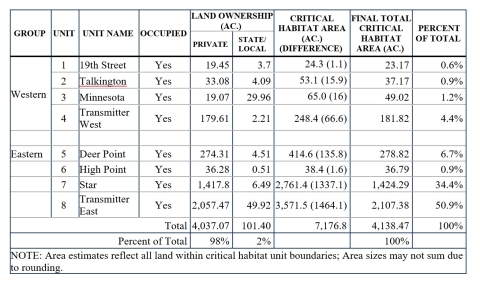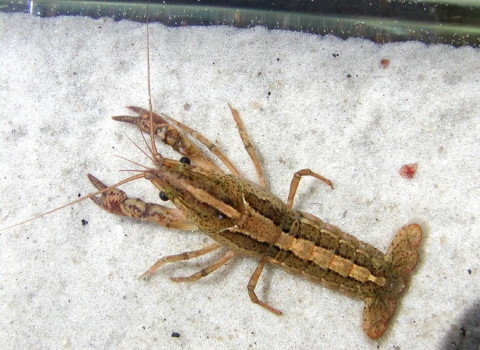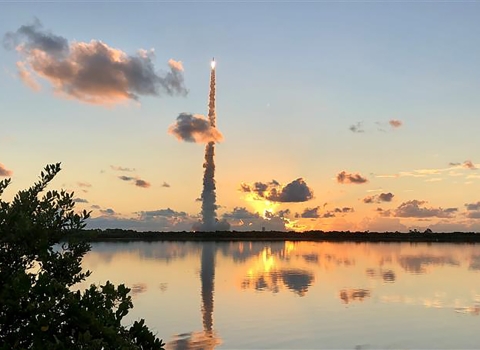Why is the U.S. Fish and Wildlife Service listing the Panama City crayfish as threatened under the Endangered Species Act?
A review of the best available science has determined that the Panama City crayfish meets the definition of threatened under the Endangered Species Act (ESA). The science indicates that the Panama City crayfish is likely to become an endangered species within the foreseeable future throughout all or a significant portion of its range. The final listing decision, 4(d) rule, critical habitat designation, and support documentation are available online at http://www.regulations.gov under Docket Nos. FWS-R4-ES-2017-0061 and FWS–R4–ES–2020–0137.
How do ESA protections benefit this species?
The listing lends greater recognition to a species’ precarious status, encourages conservation efforts by other agencies (foreign, federal, state, and local), independent organizations, and concerned individuals. Additional benefits include:
Protection from being jeopardized by federal activities; restrictions on take and trade;
A requirement that the Service develop and implement recovery plans for this species;
Authorization to seek land purchases or exchanges for important habitat; and
Authorization to issue recovery funds when available to state and non-governmental organizations with cooperative endangered species agreements.
Did the Service previously announce and accept public comments on its proposal to list the Panama City crayfish as threatened?
Yes, in the January 3, 2018, and April 15, 2021, proposed rules the Service requested that all interested parties submit comments. All substantive information provided during both comment periods was incorporated directly into, or addressed in, the final determination’s “Summary of Comments and Recommendations” section.
How does the final listing decision differ from what the Service proposed on April 15, 2021?
The listing section and associated economic analysis are unchanged from the previous proposals, however, there are several changes to the proposed 4(d) rule and critical habitat designation. The Service removed the first exception for species conservation and restoration efforts and indicated that provisions of § 17.31(b) extend to the species. Based on comments received, the Service clarified the types of right-of-way maintenance activities where take is excepted. These excepted activities include mowing, use of herbicides, mechanical side trimming, replacing critical structural components (such as cross-arms, insulators, conductors, and similar parts).
The Service also made changes to the critical habitat designation based on updated aerial photography, new information about permitted developments, and more recent information about Panama City crayfish habitat use in secondary soils. By using 2020 aerial photography, the Service removed unsuitable or developed parcels, resulting in the removal of approximately 58.9 acres (23.8 ha) and isolated areas less than 0.1 acres (0.04 ha) in size. The new aerial photography also revealed an additional 1.9 acres (0.8 ha) of habitat, confirmed by a high concentration of Panama City crayfish, and added that area to Unit 1 (19th Street). Additionally, the Service removed recently permitted development parcels that included species conservation actions that would not require special management, totaling 389.3 acres (157.5 ha).
The Service also revised the critical habitat delineation protocol based on new information concerning how Panama City crayfish uses secondary soils. These updates better represent the habitat containing the primary biological features supporting the Panama City crayfish. Given current information, Panama City crayfish is not likely to persist during drought years. Section 7 Section 7
Section 7 Consultation
The Endangered Species Act (ESA) directs all Federal agencies to work to conserve endangered and threatened species and to use their authorities to further the purposes of the Act. Section 7 of the Act, called "Interagency Cooperation," is the mechanism by which Federal agencies ensure the actions they take, including those they fund or authorize, do not jeopardize the existence of any listed species.
Learn more about Section 7 reviews in these areas will continue because the species occupy them for part of their life cycle.
As a result of these modifications, the final amount of designated critical habitat is 4,138 acres (1,675 hectares), a decrease of 3,039 acres (1,230 ha) from the proposed designation.
Did the Service consider economic impacts associated with the final listing and designation of critical habit?
Yes, the Service conducted an economic analyses (EA) to examine the economic impacts of a critical habitat designation. The Panama City crayfish EA found that the implementing cost of the rule is likely limited to additional action agency administrative effort in considering adverse modification of the crayfish’s habitat during Section 7 consultations. Based on a review of available information, no more than 12 formal consultations involving the Panama City crayfish are likely to occur in a given year. As such, the Service expects the additional administrative cost of addressing adverse modification in these consultations not to exceed $60,000 each year. Also, the critical habitat designation is not likely to trigger additional requirements under state or local regulations, nor is the designation expected to have perceptional effects on markets. The Service revised the final critical habitat designation removing 3,039 acres (1,230 ha) from the designation. Accordingly, the estimated costs in the EA will likely be less because of a smaller final critical habitat designation.
What types of criteria did the Service consider in making the final decision on listing this species?
In listing a species as threatened or endangered, the Service consider the following five factors:
The present or threatened destruction, modification, or curtailment of its habitat or range;
Overutilization for commercial, recreational, scientific, or educational purposes;
Disease or predation;
The inadequacy of existing regulatory mechanisms; or
Other natural or manmade factors affecting its survival.
What is the 4(d) rule for the Panama City crayfish?
Section 4(d) of the ESA allows the Service to establish prohibitions or exceptions to prohibitions for threatened species. A 4(d) rule conserves a threatened species by allowing regulatory flexibility under the ESA.
The provision of the 4(d) rule promote conservation of the Panama City crayfish by encouraging the management of the landscape in ways that meet the crayfish’s conservation needs and are consistent with land management considerations. The 4(d) rule helps conserve the Panama City crayfish by prohibiting the following activities, except as otherwise authorized or permitted: importing or exporting; take; possession and other acts with unlawfully taken specimens; delivering, receiving, transporting, or shipping in interstate or foreign commerce in the course of commercial activity; or selling or offering for sale in interstate or foreign commerce.
The 4(d) rule also provides for exceptions to actions and activities that may have minimal disturbance to the Panama City crayfish and are not expected to impact the species conservation and recovery efforts negatively. These prohibition exceptions include conservation efforts by the Service or state wildlife agencies, certain development practices, select land management activities, and some utility actions expected to have negligible impacts on the Panama City crayfish and its habitat.
What is critical habitat?
The ESA defines critical habitat as the specific geographic areas that contain features essential to the conservation of an endangered or threatened species that may require special management and protection. Critical habitat may also include areas not currently occupied by the species but needed for its recovery.
The areas identified as Panama City crayfish’s critical habitat have the physical or biological features needed to sustain this species’ life processes. These include:
Space for individual and population growth and normal behavior; cover or shelter.
Food, water, air, light, minerals, or other nutritional or physiological requirements.
Sites for breeding and rearing offspring.
Habitats protected from disturbances or which represent the historical, geographical, and ecological distributions of a species.
Considering the above combined with the Panama City crayfish’s limited range, the Service determined that the designation of critical habitat met the ESA criteria and would benefit crayfish conservation efforts.
How many acres did the Service designate as Panama City crayfish’s critical habitat?
Our final designation includes eight (8) units as critical habitat for the Panama City crayfish. They comprise 4,138 acres (1,675 hectares (ha)) of land, entirely within Bay County, Florida.
All units are occupied or otherwise contain Panama City crayfish populations as of this listing. Each unit is considered essential to the conservation of the species. Any actions that may affect the species or habitat in these areas would also affect the designated critical habitat. However, the Service is unlikely to recommend additional conservation efforts to address the adverse modification standard beyond those already needed to avoid jeopardizing the species’ continued existence. There are no other existing critical habitat designation overlaps with the Panama City crayfish critical habitat.
What impact does a critical habitat designation have on development in the area?
The designation requires federal agencies to ensure that actions they plan to undertake, fund, or authorize do not destroy or adversely modify that habitat. Only activities that require a federal permit, license, or funding that may impact the critical habitat area are affected. If this is the case, the Service works with the federal agency and, where appropriate, private parties or other landowners on ways they can amend their project design and allow it to proceed without adversely modifying the critical habitat. Thus, most federal projects are likely to go forward but could be modified to minimize critical habitat harm.
What are the conservation goals for the Panama City crayfish?
The Service relies on the known persistence over time of small populations. We estimate that 2,200 acres of habitat, permanently protected and actively managed within at least eight population units, should be sufficient for the species to remain viable for the foreseeable future. Currently, 230 acres are under permanent easement. The Service is working with Bay County staff to secure funds to purchase additional land for permanent protection for crayfish recovery.
A Partners Agreement between the Florida Fish and Wildlife Conservation Commission and the Service solidifies commitments by both agencies to jointly provide oversight of land management, acquisition, species monitoring, and translocations as needed to maintain and improve the species’ status.
Press release
Read the press release that accompanies these frequently asked questions.





